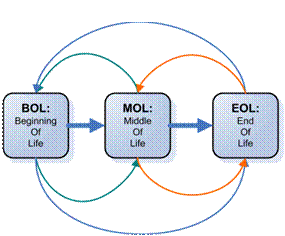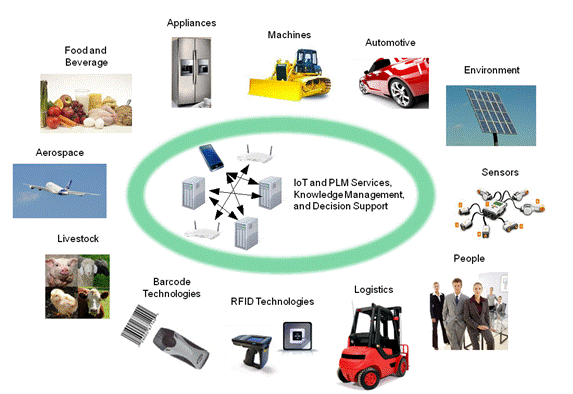An Introduction to Internet of Things (IoT) and Lifecycle Management – Internet of Things and Lifecycle Management
Probably the most significant obstacle to effective, whole-of-life lifecycle management is that valuable information is all too often locked into vertical applications, sometimes called “silos”. This information is not readily shared with other interested parties across the Beginning-of-Life (BOL), Middle-of-Life (MOL), and End-of-Life (EOL) lifecycle phases.

Closing Information Loops
Common, open, and trustworthy information exchange standards will enable the closing of information loops, allowing information to be shared through the whole lifecycle and across the whole spectrum of lifecycles: product, human, animal, food and beverage, pharmaceutical, healthcare, supply chain and logistics, pedigree and traceability, and data governance, among many others.
This concept has been called Closed-Loop Product Lifecycle Management (PLM) in literature [5]. When we speak about Closed-Loop PLM in this White Paper, we mean whole-of-life lifecycle management enabled by IoT interoperability, where information from any single lifecycle phase affects processes and decision-making in the other phases. For example, information about the condition of products at EOL may be fed back and used to affect the maintenance of similar products during MOL or to improve the design and production of future product series at BOL. Closed loops ensure that valuable information is available to all lifecycle phases.
Closing information loops across all phases of all kinds of lifecycles will make Boundaryless Information Flow a reality, harnessing and harmonizing the technologies and direction of the IoT, embracing its many trillions of additional, often autonomous entities.
Background
The initial name of the Work Group when it established in 2010 was Quantum Lifecycle Management (QLM). QLM signified a major leap beyond PLM, and the name was chosen to highlight a clear differentiation between the two. This White Paper is an updated version of the corresponding QLM White Paper: An Introduction to Quantum Lifecycle Management (QLM), published by The Open Group in November 2012. The update became necessary in order to reflect the name change decided by the Work Group in 2014; i.e., from QLM to IoT Work Group. The publication of the first official Open Group IoT standards – O-DF [8] and O-MI [9] – in October 2014 also justified updating this White Paper.
Historically, the PLM acronym is usually associated with the Beginning-of-Life (BOL) design and manufacturing phase, although conceptually it encompasses full management throughout the lifecycle. PLM has been mainly focused on information about product types and their versions. However, even a full PLM vision is highly product-centric and does not consider the wider context in which the product will exist. IoT and lifecycle management not only consider the product lifecycle but its full context of people, machines, animals, environmental conditions, etc. in order to be able to fully understand and manage the product and ecosystem.

Closed-Loop PLM extends PLM to include detailed information not only about each individual product instance – i.e., physical products – but also their usage in the Middle-of-Life (MOL) and End-of-Life (EOL) lifecycle phases (for example, see [10]). Furthermore, Closed-Loop PLM may also be applied to other kinds of lifecycles such as supply chain, food and beverage, human, services, etc. – as illustrated in Scope of Closed-Loop PLM, thus allowing the aggregation of information about each single product instance from different applications throughout its lifecycle.
The vision of the IoT Work Group is that IoT provides the necessary Systems of Systems-level interoperability between all systems producing, storing, or consuming any lifecycle-related information for fulfilling the purposes of Closed-Loop PLM. Concepts such as Closed-Loop Quality Management (for example, see www.plm.automation.siemens.com/de_ch/Images/AI-SiemensClosedLoopQuality-ML-07_tcm782-117511.pdf) and similar are addressing similar challenges to Closed-Loop PLM.
IoT and Closed-Loop PLM can only truly become reality if important societal, political, and cultural concerns are properly addressed. In order to achieve its full potential, the IoT requires a trusted and secure, open, and unified infrastructure for true interoperability. Without this, continued lack of trust and parallel development of disparate solutions, technologies, and standards will lead it to become an ever?increasing web of organization and domain?specific intranets. IoT standards will provide the basis for this infrastructure to be realized as more and more constituent “building blocks” are connected.
The open interoperability that this enables increases competitiveness of existing products and services through all lifecycle phases while also creating new business opportunities for manufacturers, distributors, service providers, consultants, regulators, and government.
Evolution of IoT and Closed-Loop PLM
PLM has its roots in product and production planning. The early concept of production planning or Manufacturing Requirement Planning (MRP) mostly concerned workflow, the coordination of orders, manufacturing to order, and stocks and procurement management. MRP evolved into manufacturing “resource” planning when production capacities and human resources were brought into the equation; and Distribution Resource Planning (DRP) brought the supply chain and external partners into the network as a natural extension.
When finance entered the arena, MRP II was born, which also served to quantify and highlight the significance of interaction between different hitherto often segregated and isolated departments. It might be said that in an effort to “bring it all together”, Enterprise Resource Planning (ERP) was born; federating projects and encompassing the enterprise at large.
PLM followed a similar evolutionary path, driven mainly by technological advances in areas of Computer-Aided Design (CAD), Computer Aided Engineering (CAE), Product Data Management (PDM), and the realization of collaborative processes between design and manufacturing organizations. Significantly, however, feedback from the field still remains very limited and almost entirely failure-driven.
In an effort to provide competitive advantage in a global marketplace where product quality is no longer a guarantee for success, production cycles and lead times are becoming shorter, and mass customization the standard. Thus, producers are looking for additional means of differentiation for survival.
Servitization is the evolution from services that support the product, through services that differentiate the product, to services becoming the product; e.g., car leasing rather than purchase, flight-hours rather than aero engines, or a warm home rather than a boiler (furnace). Sustained competitiveness in such a service environment demands extensive and continual feedback on product use and performance compared to cost.
Advances in areas of microelectronics, nanotechnologies, sensors, and Information and Communication Technologies (ICT) have opened new opportunities with proven benefits, combining multiple sensor technologies with automated identification and data capture technologies. Item-specific data can be combined with information from existing enterprise systems and converted into knowledge. This aggregated knowledge may be used to drive decision support systems in a virtually unlimited variety of application areas.
Highly selective information can be delivered or subscribed to across organizational boundaries to fuel new service opportunities, with increased efficiency and sustainability. At the same time, social networking has highlighted the potential of interconnected people. Interconnecting objects that are able to communicate with each other (the IoT) require structured and auditable protocols to deal with trust and security of information.
How organizations and people will make use of IoT and Closed-Loop PLM will fundamentally impact processes, assets, locations, roles, as well as organizations and people themselves so will be highly disruptive to the Business Architecture of IoT as a whole itself. Guidance is therefore going to be key to organizations aiming to both survive and thrive in the IoT interconnected world. The next section describes the interoperability architecture used and defined by the IoT Work Group and the main standards published and under development for implementing it.